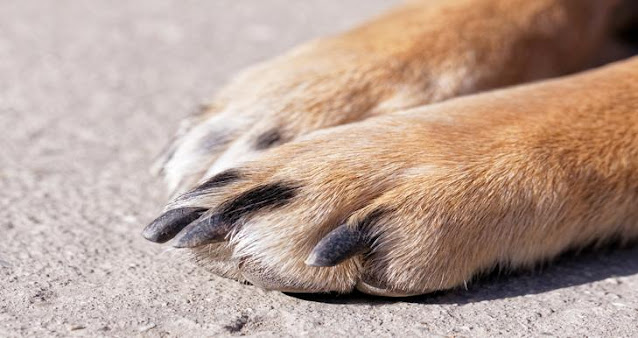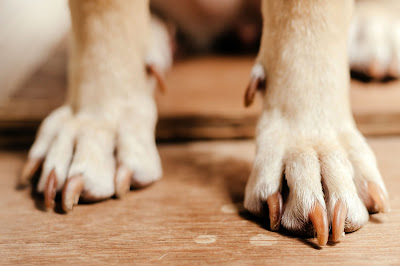When you take walks with your dog, the hard surfaces like pavement can help naturally wear down their nails, reducing the need for regular trimming. However, if your dog's nails are not naturally wearing down, it's important to take care of them. Untrimmed nails can break, bleed, or even grow into their feet, causing discomfort and potential injury. This is especially crucial for senior dogs, as overgrown nails can contribute to foot pain, particularly if they have arthritis. Regular nail maintenance is essential to ensure your dog's comfort and overall well-being during walks.
How to clip your dog’s nails
If you or your dog are new to nail clipping, it can be a bit unfamiliar at first. However, with proper preparation, a calm environment, and following these easy steps, you'll be able to do it smoothly
Before you start
If your dog becomes nervous, stressed, or aggressive during nail clipping, it's important not to force the situation. In such cases, it is recommended to seek professional help from your veterinarian.
Many veterinary practices offer nail clipping services at their clinics, which can be done easily and affordably. This ensures that your dog is in the hands of an expert who knows how to handle such situations.
This is particularly important if your dog's nails are excessively overgrown, have grown into the paw pad, or if you don't have assistance available. Attempting to clip the nails on your own for the first time can be challenging and potentially risky. Consulting a vet will provide a safer and stress-free experience for both you and your dog.
Clipping your dog’s nails
- Once you've received a tutorial from your vet or veterinary nurse, you're ready to start clipping your dog's nails. Here's a step-by-step guide to help you:
- Purchase the appropriate type of dog nail clippers from your veterinary practice or groomer. Make sure they are designed specifically for pets and are sharp and well-maintained for easier trimming.
- Depending on your dog's size, either sit him on your lap or sit on the floor next to him. The closeness will provide reassurance and make the process more practical.
- Ask a friend or family member to help by holding your dog's head and providing comforting support. Even if your dog isn't fond of nail clipping, the extra attention will likely be appreciated.
- Hold your dog's paws firmly and gently apply pressure on the pads to extend the nails outward.
- Start clipping from the very end of the nail at a 45-degree angle, ensuring that the cutting end of the nail clipper is facing the nail.
- If your dog has dark nails, trim thin sections off the end to avoid accidentally cutting the quick, which is the soft part of the nail. If you notice a black dot in the center of the nail, you have reached the quick and should stop cutting immediately. If you're unsure about how much nail to remove, consult your vet or veterinary nurse for guidance.
Remember, patience and caution are key during the nail clipping process. Take breaks if needed and reward your dog with treats and praise for their cooperation.
White dog nails
On white dog nails, the quick is in the pink section (which you cannot see in black nails) – again, try hard not to nick it! The quick contains nerves and blood vessels that when nicked will bleed easily.
How often should you clip your dog’s nails?
To ensure proper dog nail care, it is recommended to trim your dog's nails once a week if possible, but at least twice a month. The frequency may depend on your dog's specific needs and how often they walk on hard surfaces like roads. It's important to remember that taking off small amounts of nail regularly is preferable to removing larger portions infrequently. This approach helps maintain the appropriate nail length and avoids discomfort for your dog.
What to do if your dog’s nails bleed
Keep silver nitrate sticks and cotton wool balls on hand in case you accidentally cut the dog's nail too short and it starts bleeding. If this happens, remain calm and apply the silver nitrate to the end of the nail. Gently press a cotton wool ball against it for a moment to help stop the bleeding. However, if the bleeding persists, it's important to consult your vet immediately for further assistance with the dog nail clipping process. Keep in mind that silver nitrate may cause a stinging sensation, so if necessary, ask your helper to hold your dog during the application.
Dog claw trimming tips and tricks
Don't forget to trim your dog's dew claw nail, which is located on the inside of the leg. If left untrimmed, these nails can grow into the soft tissue, similar to an ingrown toenail for humans.
If you're feeling a bit apprehensive, that's okay. The more frequently you trim your dog's nails, the more comfortable you'll become with the process.
Start teaching your dog about nail trimming from a young age to get them used to having their paws handled. You can make it a fun game by pretending to trim their nails, touching their paws, and rewarding them with treats.
Always remember to reward your dog after nail trimming to make it a positive experience for them.
If you're dealing with older or younger dogs with soft or brittle nails, you can use a regular nail file to gently file their nails instead of cutting them. This method is less likely to cause pain or bleeding.
When you're checking your dog's nails, also inspect their paw pads for any cuts or foreign objects. Grass seeds can be a common annoyance during summertime as they can get lodged between their toes. Additionally, check between their toes for any signs of soreness, and if you notice anything unusual, don't hesitate to contact your vet.
Trimming your dog's claws can be challenging, so don't feel guilty if you're unable to do it yourself. If you're unsure or need further reassurance, consult your vet or vet nurse—they'll be happy to assist you.





